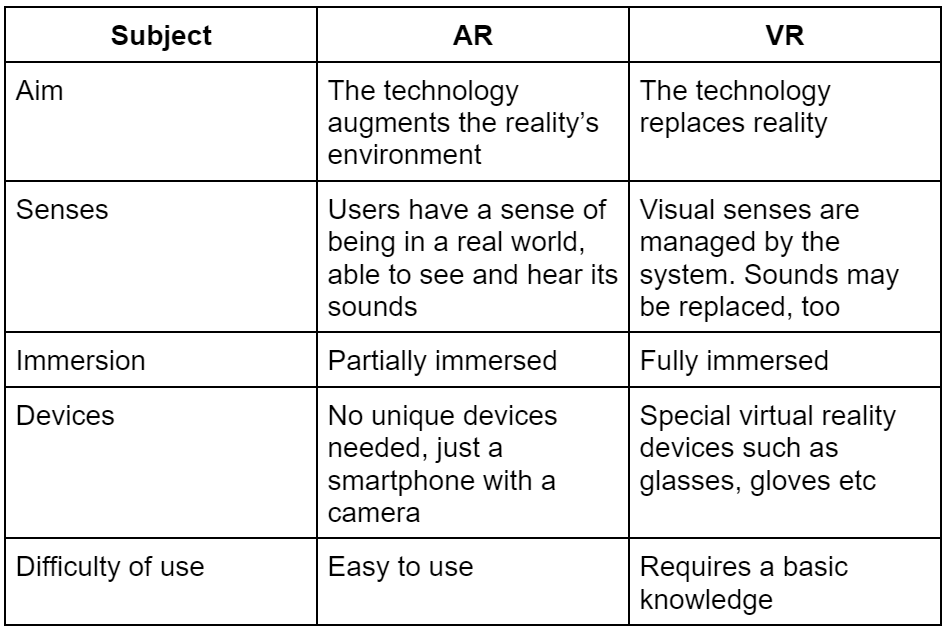Augmented Reality Vs. Virtual Reality In Crypto Space

This blog post will cover:
- Augmented reality
- Virtual reality
- The difference between AR and VR
- Mixed reality
- Crypto projects using AR or VR
- Conclusion
The digital world is getting more advanced every year. Sometimes it gets so twisted even the well-informed people can’t keep pace with the technologies. That’s why today's subject is two types of realities — not those we live in (yet), but the ones that are complementing our lives.
Augmented reality and virtual reality — completely different terms even though they are often used interchangeably. These technologies appear not only in the gaming industry — there are many crypto projects utilizing VR and AR. We will tell you about the most successful ones today.
Let’s find out what these words mean, explore the working principle and see what’s the key difference between them.
Augmented reality
Augmented reality, or AR, combines the parts of both digital and material spaces. It’s a special technology that similarly runs on mobile phones and PCs/laptops. The uniqueness of AR is an ability to demonstrate digital pieces in reality.
Augmented reality is constructed to expand the surroundings and let digital things cooperate with real objects. AR makes virtual environments interact with real ones thanks to the information provided.
How does it work?
Usually, AR does not need any special equipment to start working — you can use your smartphone to see how it operates. Virtual 3D models are overlaid by the AR systems real-time. The program scans the physical world through the camera, uses the geometric measurements to place the objects in the right places and voila — you can see the result on your phone screen! AR has an opportunity to deliver a view of the real-time data flowing from products and give users a chance to manage them via the touchscreen, gesture or voice.
To get an accurate representation, think about Snapchat or Instagram filters, interior design programs with various decorations, or even the Pokémon Go game, which still stays popular among both kids and adults.

Pros and cons
However, everything has its own benefits and drawbacks especially when it comes to modern technologies as they still need years of additional development. Here are the features of augmented reality to highlight.
Advantages:
- AR makes the studying process more complete and interesting which might affect the educational institutes a lot.
- Simple to use — augmented reality doesn’t require any special hardware, it’s enough to have a smartphone or a tablet.
- A huge range of AR apps that are getting more advanced each year.
- The technology is used in a wide number of sectors including gaming, marketing, education and crypto, too.
- Long distance is no more an obstacle to sharing any experience or knowledge.
Disadvantages:
- AR implementation is quite expensive.
- Many devices do not support AR or are too weak to perform using this technology. For example, your phone or a tablet should have 1 GB of space to perform and it must initially support the function of AR (most merchants highlight this information in the product description).
- Augmented reality seriously lacks user privacy.
- It is not focused on security much, which may lead to multiple data leaks.
Virtual reality
Virtual reality, or VR, is a technology made to reconstruct three-dimensional pictures and videos to recreate a brand new virtual reality. The main goal of virtual reality is to make a feeling of immersion in a real size 3D models, environment, situations etc.
This type or reality is much older than AR, as the beginnings of VR technology can be seen in the beginning of the 20th century, when the Pygmalion's Spectacles story by Stanley Weinbaum was released. The main character wears glasses that bring him to a fictional reality.
How does it work?
To create 3D models, many of which copy the real or digital environment, virtual reality tech utilizes computer vision and special graphics to attach some depth and rebuild the gap between objects. This technology is made to supersede the real surroundings with virtual ones.
In order to manage digital reality, people use PCs and devices such as VR headsets with sensors or gloves. They help users to experience the VR world and interact with it more naturally.
VR is widely used in different spheres such as entertainment, gaming, education, business.
Pros and cons
We would love to say that VR is perfect nowadays, but unfortunately we can’t. However, it’s being developed and improved. Take a look at VR’s pros and cons.
Advantages
- Immersive learning is available with VR.
- An opportunity to discover the virtual world.
- Education sphere could significantly benefit from VR as today’s students are interested in new technologies and the digital environment.
- Many sectors could use VR for potentially dangerous practice: e.g. difficult surgeries and plane flights.
Disadvantages
- A true-life interaction isn’t possible in VR.
- Some consider it a minus — VR might become too good that people would want to switch to digital life completely.
- Even though studying and training in virtual reality is comfortable and safe, it can’t completely replace real practice.
The difference between AR and VR
There are many differences between the two types of realities, even if we think that they have a lot in common. It’s important to understand the key features of each to distinguish AR and VR.

Mixed reality
There is also a third type of reality that we haven’t mentioned before. It’s a mixed reality. A quite new term combines AR and VR and merges digital and physical worlds to create a brand new environment in which people can interact with both virtual and real subjects.
MR technology constantly gathers fresh data about the environment. MR is not that popular as AR or VR, but it still can work well with several sectors including education, medicine, army, marketing and so on.
There are many examples of different brands implementing MR. For instance Nike — they have created their own store in Metaverse where customers can choose the virtual shoes while shopping and receive a real pair of sneakers they have picked. Over 7 million people have visited the virtual Nike store in less than 6 months.

Crypto projects using AR or VR
Despite the fact that both technologies aren’t used for so long in Crypto World, there already exist a couple of projects worth your attention. Let’s have a look at the list.
Ceek VR (CEEK)
CEEK is a project that allows fans to connect with their favorite artists, and let creators of content monetize their work. The payments are confirmed through the blockchain, which ensures a fair and fast monetization.
To get access to the project’s Metaverse, one should use the special virtual reality headsets such as Oculus, HTC Vive or CEEK mobile. The main CEEK’s goal is to deliver a user-friendly experience and let anybody join the VR Metaverse where both artists and audience can co-exist and be mutually beneficial.
Metahero (HERO)
Metahero generates 3D avatars and virtual things which later could be used in social media, games, fashion, and a couple of other sectors. Metahero was born in 2021 and its initial aim was to speed up the evolution into a parallel digital sphere and promote crypto adoption.
Metahero also holds on to the concept of metascanning to scan and create avatars for the Metaverse. The whole concept could be described as a bridge between two realities — virtual and physical.
VibeHub (VIBE)
VibeHub is a wide project with many products in its ecosystem. Mainly, it aims to create realistic hologram views, and engage users into the metareality. It’s enough to just imagine a virtual spot on a live concert that looks like you’re actually on a show, or a virtual meeting with your favorite artist. This is what VibeHub looks like. Education, entertainment and other spheres are also involved — people can find boxing classes, guitar lessons, yoga practice etc.
The concept of the project expands the boundaries of what is possible, creating the impression that you live in the 22nd century. However, all the above said is available now you can just visit the Metaverse of VibeHub.
Conclusion
VR and AR help people not “to avoid reality”, but to immerse themselves in a new one, to experience the technology of the future which is available nowadays. We’ve learned that virtual and augmented realities are really two different technologies that many people think are synonymous. But this is not correct, and now you will clearly understand where reality is augmented and where it is replaced!
If you are interested in Metaverse, make sure to check out our previous articles about virtual but real weddings, digital fashion shows, Metaverse real estate and music concerts! The full relevant list of projects created in virtual reality is here.

